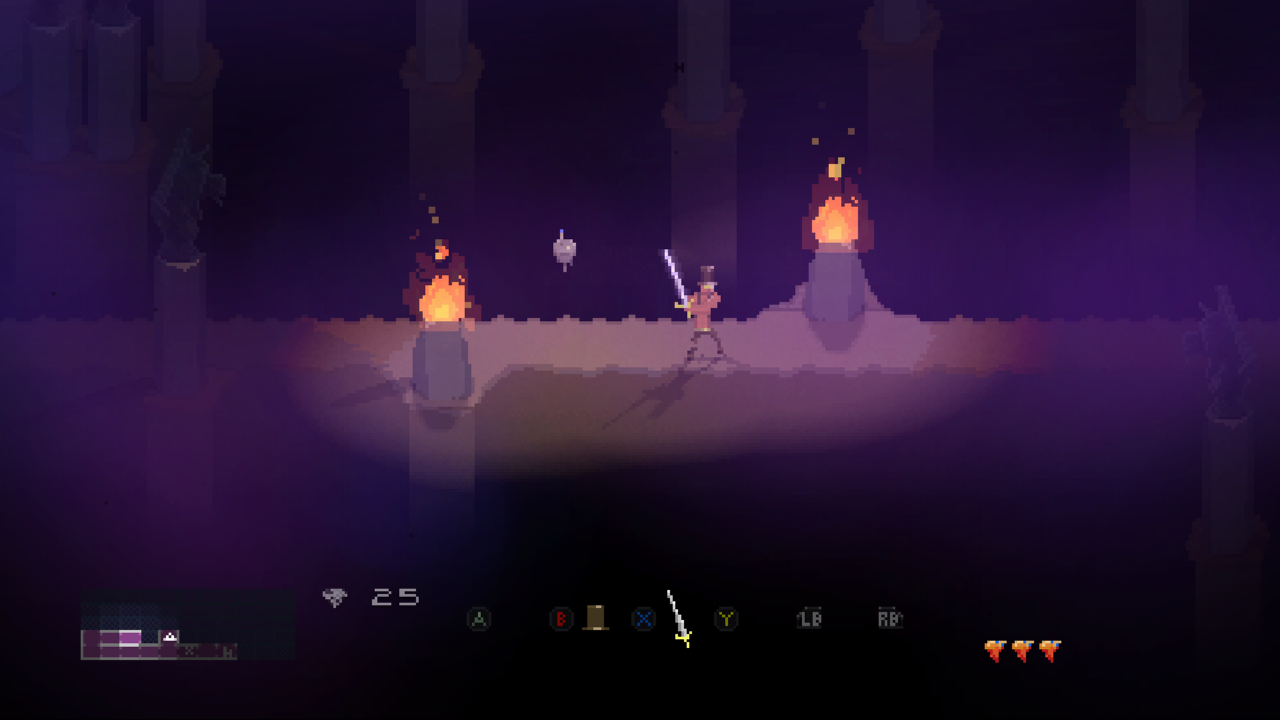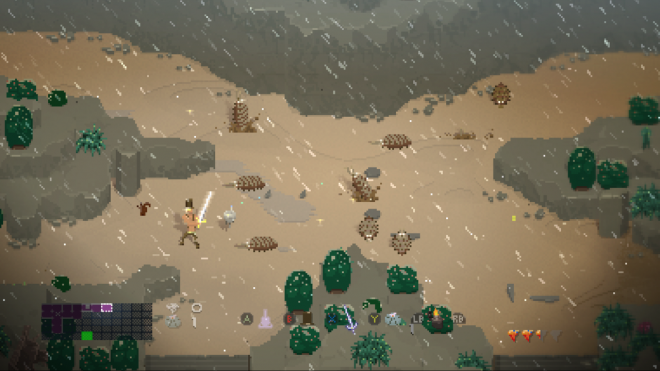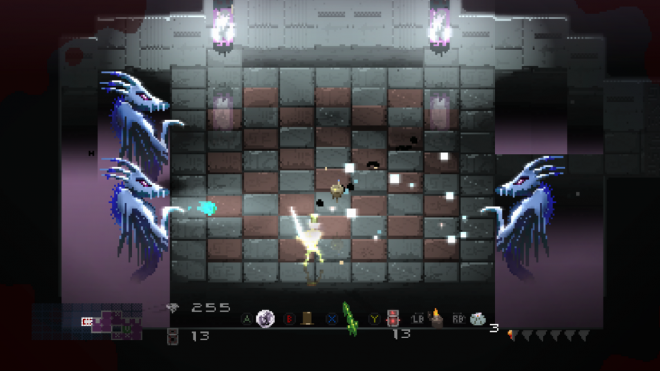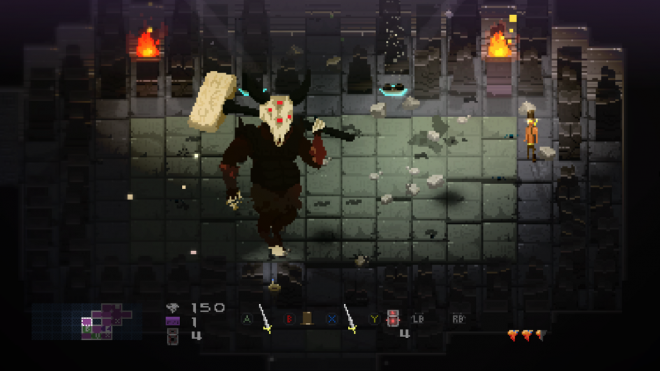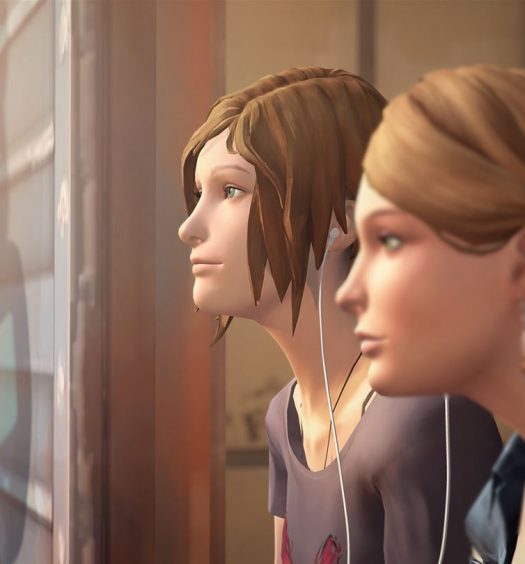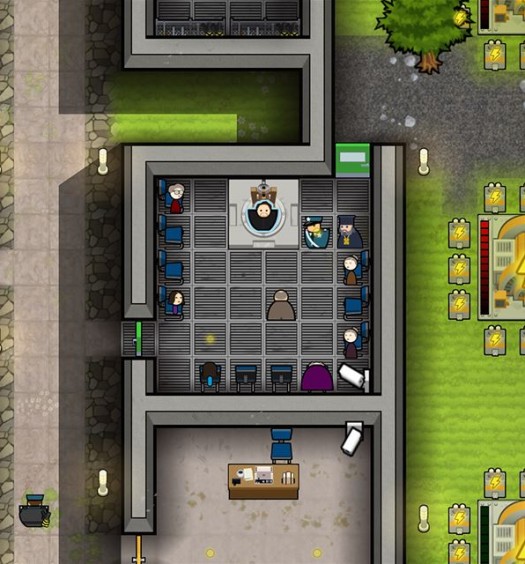Have you ever been replaying the original Legend of Zelda for the hundredth time and thought “I’m tired of this game always being the same, if only it were different every time I played.” Well, Songbringer is aimed to solve that problem. The game puts you in the shirtless role of Roq, who has woken up on a mysterious planet. After stealing a cool sword and accidentally awakening some demons, he and his robot companion Gib must undo their mistake and get back to their space-faring vessel, the titular Songbringer. It’s like a more stylized and sci-fi The Legend of Zelda, if that game had a heavy prog-rock influences and strongly encouraged the use of hallucinogenic drugs.
Here’s what I liked
Dangerous to go alone – First and foremost, Songbringer creates a world that is a ton of fun to explore. Much like the original Zelda, you explore an open world that is a series of interconnected static screens from a top-down perspective. Scattered throughout the world is a series of dungeons that must be completed to finish the game, as well as a plethora of secrets and other goodies, which can be played in any order. As you progress you gain numerous weapons, tools and abilities which can be assigned to any face button or bumper through the game’s streamlined inventory menu. The world is full secrets, which can be found through multiple means including exploding secret walls or taking hallucinogenic drugs to see things you normally can’t. It’s a lot of fun to explore and try to find everything the game has to offer.
Random – Every run-through of the game is randomly generated, and it does this in a pretty clever way. When creating a new save file, you must type in a six letter word, which not only labels your save but also is used as the seed for generating the world. Every combination of letters creates a different world, but using the same word twice will create the same exact world. On later playthroughs, you can decide to do something familiar or new, and you can easily share a particularly interesting world with other players. The endless permutations make for some interesting setups in the overworld; while the starting screen is always the same everywhere else is shuffled around or traded with other tiles, potentially causing you to experience events in a different order and play the game in a very different way.
Here’s what I didn’t like:
Random – Unfortunately, the benefits of random generation only go so far here. Every playthrough is still going to hit the same story beats, adventure through the same environments with the same enemies and go through the same dungeons with the same bosses using the same tools and weapons. Even in a single playthrough things start to feel same-y, especially as dungeons largely use the same ancient technology tile set and reuse a lot of room setups. With each playthrough being a multi-hour quest in which you’re going to see almost everything the game has to offer, the randomization isn’t as big a draw as it may initially seem.
Combat – Fighting is mostly done through three weapons – a sword, a projectile boomerang hat, and bombs. While doing average exploring it works fine and dandy, but when put into the pressure-cooker of a dungeon the flaws really show. Sword combat is just swinging wildly, which feels imprecise and lacks good feedback. Getting close enough to an enemy to use the sword almost guarantees you’ll take damage, so projectiles are usually the way to go. Dungeons often throw you into rooms jam-packed with enemies, forcing your hand to use bombs as standard means will kill you quickly, but in order to do that, you must get close enough and therefore take lots of damage. There are some enemy types that rush at you which are almost impossible to kill. Clearing a dungeon is often done a room or two at a time, as you’ll quickly die and be thrown back to the beginning. This is all before you get to the dungeon-ending boss battle, which takes a long time and has no health bar or any other indication of your progress. The 2D art style causes some bosses to have confusing hit boxes; they appear to be towering over you, yet you can get damaged by parts of them that should be way above your head. There are ways to make things easier, most notably through weapon upgrades which can be found throughout the world or at the forge unlocked later in the game, but that’s only so long as you happen across a really good seed.
Stop talking – Songbringer is a lot more upfront about its story than its inspiration, and that doesn’t work to its favor. The writing is pretty bland, and there’s often some moments in a conversation or entire cutscenes that just feel useless. The story often ruins the flow of the game, plugging in flashbacks or meanwhiles at random moments in your adventure. Dialogue is not spoken aloud, instead delivered through speech bubbles above the character’s heads. The pixellated font used can be hard to read, made even more difficult by color choices that blend into the environments. Every time the game pauses for story, it just falls limp and frustrates, making any interesting insight into the game’s universe feel more like an annoyance. My biggest pet peeve is how the protagonist cheers whenever a bomb goes off, whether or not it did anything useful.
Wrap-up:
Songbringer is a good approximation of a classic exploration-based adventure – when it sticks to the overworld. The dungeons up the challenge in a very uncomfortable way and do little to support the game’s strengths. Even though the hub fares better, it’s still where the bulk of the grating story happens, so no part of the game is without its frustrations. Sure, throwing around a boomerang top hat has its moments, but it’s not worth slogging through the dungeons to experience.
Score: Limited Appeal
Songbringer was developed Wizard Fu Games and published by Double Eleven Limited. It was released Friday, September 1 for $19.99. A copy was provided for review purposes.

